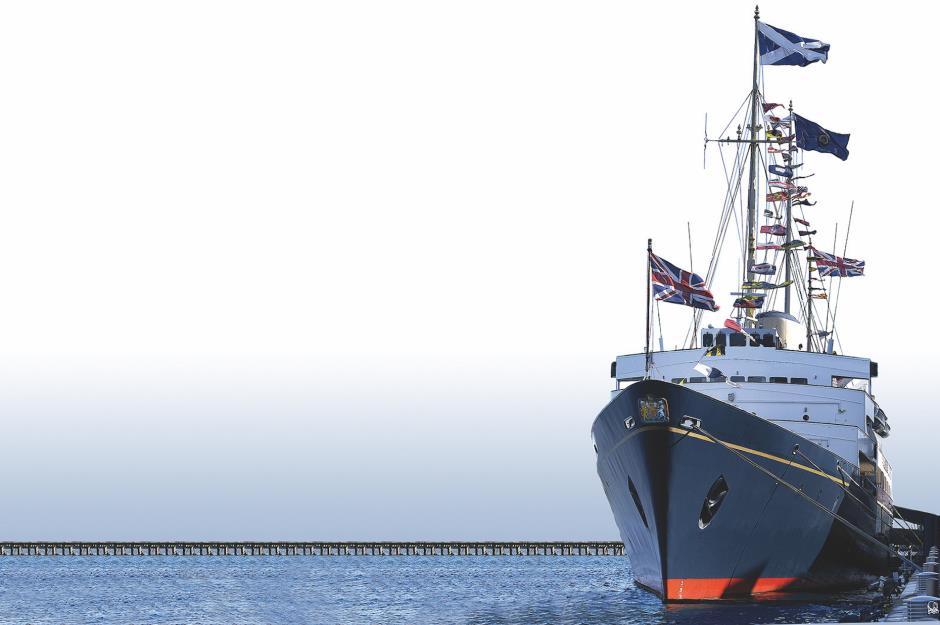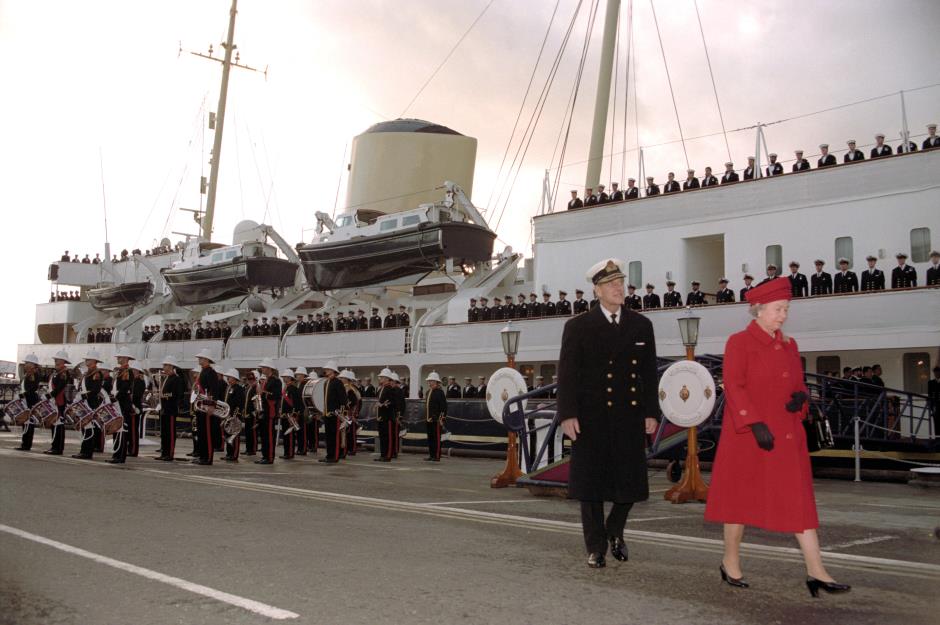Inside the historic Royal Yacht Britannia

www.royalyachtbritannia.co.uk
A right royal vessel
The Royal Yacht Britannia was the last in a long line of royal yachts. During its career, Britannia travelled 1,087,623 nautical miles – calling at more than 600 ports in 135 countries. The enormous vessel was also witness to many historic meetings and events, and the honeymoon location for more than one royal couple. Here, we take a tour aboard the glamorous yacht.

John Stillwell/PA Archive/PA Images
The last of a long legacy
When the Queen and Duke of Edinburgh disembarked Britannia for the last time at a decommissioning ceremony in Portsmouth in 1997, it ended a tradition that dated back to 1660 and the reign of Charles II. Britannia was the last of the 83 different British Royal Yachts owned by the monarchy.
The launch party
Commissioned by King George VI on 4 February 1952 (sadly, he didn't get to see her built as he died just two days later), the 412-foot-long vessel, which served the Royal family for 44 years in total, began her illustrious career in the John Brown & Company shipyard in Clydebank. She was launched into the water from here on 16 April 1953. Around 30,000 people went along to the launch ceremony to hear the Queen say: "I name this ship Britannia." Champagne was considered too extravagant in post-war times so the Queen smashed a bottle of Empire wine instead.
Hidden treasure
Before that the name had been a closely guarded secret. In fact, the name Britannia is not written anywhere on the hull of the famous ship, which was painted a deep blue as requested by the Queen rather than the traditional colour of black. As a ship of state, Britannia has three masts – beneath the base of each are hidden coins. They were placed there as payment to the angels to guard the souls of the sailors.
Official excursions
Britannia was the very first (and last as it turned out) royal yacht to be built with ocean-going capacity so it could act as a royal residence on state visits. Before that Royal Navy warships or passenger liners were used for overseas tours. Britannia sailed the equivalent of once round the world for each year, calling at over 600 ports in 135 countries. She undertook 968 official visits in total.
www.royalyachtbritannia.co.uk
A hospital ship
Built in post-war Britain, Britannia was also designed to convert to a hospital ship in case of war. On board is an operating theatre, X-Ray room, dental surgery, and laboratory. Up to 200 patients could be accommodated in the royal apartments if necessary. Fortunately, she never had to carry out this service.
www.royalyachtbritannia.co.uk
A legacy of Elizabeth II's reign
Prince Philip said of the beloved yacht: “Britannia is special for a number of reasons. Almost every previous sovereign has been responsible for building a church, a castle, a palace or just a house. The only comparable structure in the present reign is Britannia. As such she is a splendid example of contemporary British design and technology.”
A feat of engineering
The yacht’s engine room is an impressive piece of marine engineering – it has barely changed since it was first built in the 1950s. Virtually all of its machinery and gadgets operated faultlessly until it was decommissioned in 1997. The extremely powerful engines were capable of developing a total of 12,000 horse power and drove the yacht at 21 knots. There were 80 engineers among the yacht’s crew with around eight men on duty in the engine, boiler and machinery rooms at any one time.
The bridge
This tiny area was the central control point of the yacht – it was here that the officers navigated, log books were recorded and orders issued. The only chair in the room was for the exclusive use of the admiral – the captain of Britannia, who was ultimately responsible for the safety of the Queen, the yacht, and the crew. Everyone else was expected to be upstanding and on high alert at all times.
The crew
Britannia was the only ship in the world to be captained by an admiral – she was helmed by a total of nine admirals and one commodore over the years. The full crew included 220 yachtsmen (known as the Yotties), 20 officers, three season officers and on royal tours, a Royal Marines Band of 26 men. Officers had comfortable quarters but the crew's were pretty pokey – up until 1973 Britannia was the last ship in the Navy where sailors slept in hammocks.
www.royalyachtbritannia.co.uk
A ship of two halves
Britannia may have had lavish royal apartments but forward of the funnel it was a functional Royal Navy vessel. The crew and operational equipment were located in rather cramped conditions. Onboard protocol forbid shouting – orders were given by hand signal and white plimsolls worn to preserve the peace. Any work undertaken near the royal quarters had to be completed by 8am and if a yachtsman met a member of the royal family he had to stand still and look straight ahead until they had gone.
State visits
The Queen's sitting room was where she'd meet with her private and press secretaries to discuss the details of her royal visits. She'd usually spend several hours of a day in this room attending to state business – documents would be flown out to her at sea. When she was on a state visit, 45 extra staff from the royal household were brought on board. Plus, an impressive five tonnes of extra luggage was also required for such trips.
Martin Keene/PA Archive/PA Images
Historic meetings
The Queen sailed on Britannia to meet numerous heads of state including Nelson Mandela. The Queen’s last state visit aboard Britannia was to South Africa in 1995 where the president met the Queen as she stepped off the yacht. It was her first visit to the country since 1947, and during this historic visit South Africa rejoined the Commonwealth, which it left in 1961. The two are said to have been good friends.
Entertaining in style
Many political leaders stepped aboard the impressive vessel to dine with the Queen, including Sir Winston Churchill, Rajiv Ghandi, Margaret Thatcher, Boris Yeltsin, Ronald Reagan, and Bill Clinton. Other famous faces include Noël Coward who entertained the royals on the drawing room's Welmar baby grand piano, which was bolted to the deck in case of choppy waters. Lavish dinners took place in the State Dining Room, Britannia's grandest room.
www.royalyachtbritannia.co.uk
Fine dining
Banquets were a serious affair where absolute attention to detail was required by the crew: it took three hours to set the 56 places for a state banquet. Not surprising really, considering the position of every knife, fork and spoon was meticulously measured with a ruler. Menus, which were printed in French (naturellement) before Britannia set sail, were given to guests as a souvenir. Whenever the royal family was on board chefs were flown out from Buckingham Palace to prepare their food.
John Stillwell/PA Archive/PA Images
Defining moments in history
Britannia was witness to some key moments of modern history. Most notably, the yacht was used to rescue over 1,000 refugees from war-torn Aden in Yemen in 1986. Her last official role saw her voyage to Hong Kong for the handover in 1997. After the Union Jack was lowered at the stroke of midnight on 30 June 1997, the last governor of Hong Kong Chris Patten and his family sailed out of the harbour on board Britannia with Prince Charles.
A private residence
When it wasn't being used in an official capacity, Britannia was a special place for the Queen and her family to retreat to. “Britannia is the one place where I can truly relax,” she said. The teak-lined sun lounge was reportedly her favourite space – it’s where she took breakfast and afternoon tea, taking in the lovely views from the lounge's large picture windows.
Lighttraveler/Shutterstock
Summer cruise to Scotland
Every summer the royal family would set sail to the western isles of Scotland for a break from official duties (and the paparazzi). Britannia would stop at remote beaches on islands such as Colonsay, Skye, Eigg, Rhum and Harris for picnics and barbecues. She'd then sail along the northern coast stopping in at the Queen mother's home at the Castle of Mey near John O'Groats and ending at Aberdeen where the Queen went on to her Balmoral residence.
Relaxed protocol
The usual strict protocol on Britannia became altogether more relaxed during these holidays, although the officers did create a booklet titled "Western Isles Without Tears" to ensure everything went smoothly. Particular attention was paid to the beach barbecues. With the royals shipped ashore by a dedicated crew on the royal barge and the numerous tents, hampers and games required (not to mention the band that often accompanied them), these were clearly not your average beach barbecues.
Love boat
Four royal honeymoons took place on board in the so-called honeymoon suite (the only bedroom with a double bed). In 1960, Princess Margaret and Antony Armstrong-Jones sailed around the Caribbean. Princess Anne and Captain Mark Phillips also chose the Caribbean for their honeymoon in 1973 – although violent storms meant they were seasick for the first week. Charles and Diana sailed around the Med while Prince Andrew and Sarah Ferguson travelled around the Azores.
Final voyage
All of the clocks on Britannia were stopped at 15:01 on 20 October 1997 when the Queen was piped ashore for the last time. The decommissioning ceremony saw the Queen shed a rare tear in public as she bid the yacht she was immensely fond of farewell. Since 1998, Britannia has been berthed in Leith, Scotland, and is open to the public as a museum.

